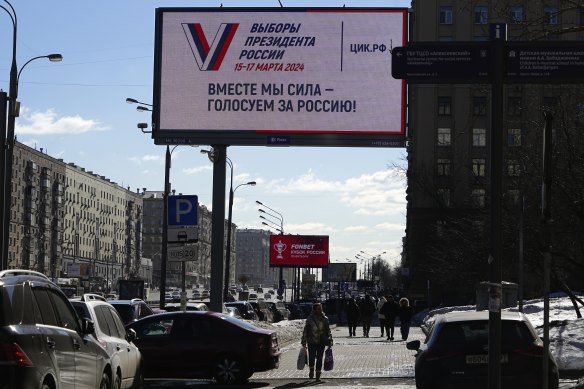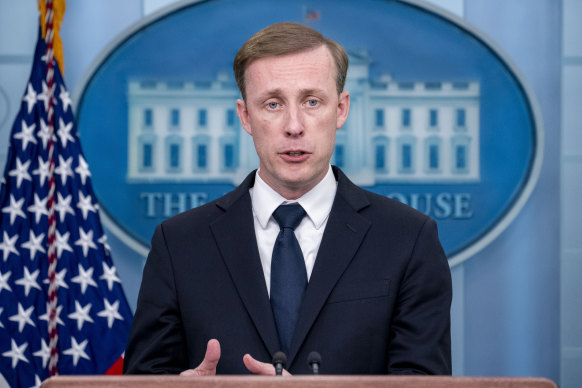
Soldiers, who Kyiv officials say are Russian volunteers fighting for Ukraine, claimed to have crossed the border. The Freedom of Russia Legion, the Russian Volunteer Corps and the Siberian Battalion released statements and videos on social media claiming to show them on Russian territory. They said they wanted “a Russia liberated from Putin’s dictatorship”.
The authenticity of the videos couldn’t be independently verified.
Fighters coming out of Ukraine attempted to reach the town of Tetkino, which lies close to the border, according to the governor of Russia’s Kursk region, Roman Starovoit. He said Tetkino was being shelled.
“There was an attempt by a sabotage and reconnaissance group to break through. There was a shooting battle, but there was no breakthrough,” he said in a video message on Telegram.
The Russian Defence Ministry said the Tetkino attacks were driven back, but provided no further details.

People walk past a billboard promoting the upcoming presidential election with words “Together – we are force!” in Moscow on Tuesday.Credit: AP
It also said Ukrainian fighters attempted to cross into the Belgorod region at least four times, but warplanes, artillery and missiles repelled all the attacks.
The representative of Ukraine’s intelligence agency, Andrii Yusov, told Ukrainska Pravda that the military groups were made up of Russian citizens.
“On the territory of the Russian Federation, they operate completely autonomously and independently,” he said.
In May, Russia alleged that dozens of Ukrainian militants crossed into one of its border towns in the Belgorod region, striking targets and forcing an evacuation before more than 70 of the attackers were killed or pushed back by what the authorities termed a counterterrorism operation. Ukrainian officials have denied any link with the group.
Meanwhile, one Ukrainian drone struck and set ablaze an oil refinery in the Nizhny Novgorod region, according to regional governor Gleb Nikitin. That region is located some about 775 kilometres from the Ukraine border.
In another deep strike, a drone was shot down in the Moscow region, Moscow mayor Sergei Sobyanin said. Though it was brought down well south of the city centre, the drone was close to Zhukovsky Airport, one of Moscow’s four international airports.
Another drone hit an oil depot in Oryol, 116 kilometres from Ukraine.
Ukrainian President Volodymyr Zelensky said last year that his country had developed a weapon that hit a target 700 kilometres away, in an apparent reference to drones.

Snow covers the photograph of a fallen Ukrainian serviceman at a memorial in downtown Kyiv, Ukraine.Credit: AP
The Russian Defence Ministry said Ukrainian drones were also intercepted on Tuesday over the Belgorod, Bryansk, Kursk, Leningrad and Tula regions of Russia.
Kyiv has staged increasingly bold attacks behind the 1500-kilometre frontline running through eastern and southern Ukraine. It has also increasingly deployed sea drones in the Black Sea, where it claims to have sunk Russian warships.
Loading
Kyiv’s forces are hoping for more military supplies from Ukraine’s Western partners, but are meanwhile struggling against a bigger and better-provisioned Russian army that is pressing hard at certain frontline points inside Ukraine.
Zelensky said that recent Russian advances have been halted and that the battlefield situation is now significantly better than in the past three months.
“We had some difficulties due to the lack of artillery shells, long-range weapons, sky blocking and the high density of Russian drones,” Zelensky said in an interview with France’s BFM TV and Le Monde published late Monday on the Ukrainian presidential website.
Also on Tuesday, an Il-76 heavy-lift transport plane of the Russian Air Force with 15 people on board crashed while taking off from an air base in the Ivanovo region in western Russia, the Defence Ministry said. Its statement didn’t specify whether there were any survivors. The ministry said that an engine fire during takeoff was the likely cause of the crash.
President Joe Biden’s administration said the US will send a new military aid package for Ukraine worth $US300 million ($454 million), the first such move in months as additional funds for Kyiv remain blocked by Republican leaders in Congress.
The White House has been scrambling to find ways to send more military assistance, given the situation on the battlefield and the resistance to the funding from Republican hardliners.

White House national security adviser Jake Sullivan.Credit: AP
US National Security advisor Jake Sullivan said the funding was coming from unanticipated cost savings from Pentagon contracts and would be used for artillery rounds and munitions for high mobility artillery rocket systems (HIMARS).
“This ammunition will keep Ukraine’s guns firing for a period, but only a short period,” Sullivan told reporters. “It is nowhere near enough to meet Ukraine’s battlefield needs and it will not prevent Ukraine from running out of ammunition,” Sullivan said.
The last drawdown was in December 2023, when funds to replenish stocks fell to zero. US officials have also looked at options for seizing some $285 billion in Russian assets immobilised in 2022 and using the money to pay for Ukraine’s weaponry.
Biden, a Democrat, has backed military aid to Ukraine since Russia’s full-scale invasion in 2022, while his likely Republican opponent in the November 5 US election, former president Donald Trump, has a more isolationist stance.
Republican House of Representatives Speaker Mike Johnson, an ally of Trump, has so far refused to call a vote on a bill that would provide $US60 billion more for Ukraine.
AP, Reuters
Get a note directly from our foreign correspondents on what’s making headlines around the world. Sign up for the weekly What in the World newsletter here.









 Add Category
Add Category